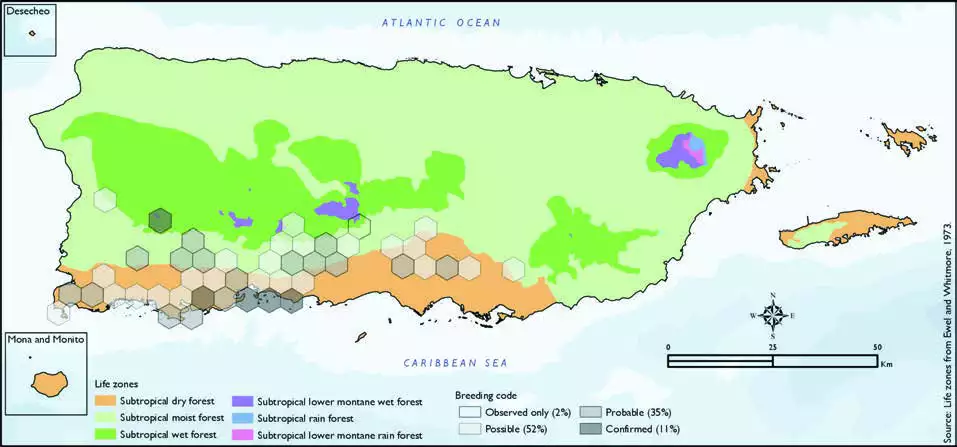Puerto Rican Nightjar
Description
The Puerto Rican nightjar or Puerto Rican Whip-poor-will (Antrostomus noctitherus) is a bird in the nightjar family found in the coastal dry scrub forests in localized areas of southwestern Puerto Rico. It was described in 1916 from bones found in a cave in north central Puerto Rico and a single skin specimen from 1888, and was considered extinct until observed in the wild in 1961. The current population is estimated as 1,400-2,000 mature birds. The species is currently classified as Endangered due to pressures from habitat loss.
Distribution & Habitat
The Puerto Rican Nightjar is endemic to Puerto Rico where it
is rare to locally common in and
around the Guánica State Forest
(Raffaele and others 1998, Vilella
and Zwank 1993). Historically, its
distribution may have included
the northern karst from where it was originally described, but
currently it is mostly restricted
to southern Puerto Rico from
Cabo Rojo to Guayama (Reynard
1962, Vilella and Zwank
1993). Its distribution includes
privately owned lands between
the Guayanilla-Peñuelas area
(USFWS 2017, Vilella and Zwank
1987), as well as the Susúa
(Oberle 2018, Vilella and Zwank
1993) and Maricao (Delannoy
2005, Vilella and Zwank 1993)
State Forests, and other localities
including La Parguera and
Sierra Bermeja in Lajas (Oberle
2018, Vilella and Zwank 1993),
and Guaniquilla, El Combate
(Raffaele and others 1998), and
Peñones de Melones in Cabo
Rojo (Díaz-Méndez and Vicenty
2005). Typical habitat for this
species includes xeric limestone forests along the southwestern
coast of the island, dry
deciduous and semideciduous
forests with dense leaf litter,
evergreen forests, and sometimes
riparian areas and plantations
(Oberle 2018; Raffaele and others
1998; Vilella 1989; Vilella and
Zwank 1987, 1993). The atlas
fieldwork yielded a total of 146
records within 46 hexagons or 10
percent of the 479 total hexagons
(see map). Of the 46 hexagons
where this species was found,
breeding met the atlas definition
of confirmed in 11 percent (5)
of the hexagons, probable in 35
percent (16), and possible in 52
percent (24), while the species
was observed in 2 percent (1)
of the hexagons but without
evidence of breeding (see map). Puerto Rican Nightjar distribution. The map shows the highest breeding code by hexagon and overlaying the ecological life zones in
Puerto Rico. Note: percentages may not total 100 due to rounding. 77Puerto Rican Nightjar/Guabairo

Breeding Habits
Previously published reports indicate that the Puerto Rican
Nightjar breeds from late
February to early July (Raffaele
and others 1998). The nesting
occurs directly on a dense leaf
litter layer of the forest fl oor,
often under a low bush (Biaggi
1997, Oberle 2018, Raffaele and
others 1998). Atlas results show
that this species breeds from
December through August with
the most breeding activity from
February to May (see chart).
Breeding activity peaks during
May, and it mostly takes place within the subtropical dry forest
life zone (60 percent of the
hexagons) (see table). It also
breeds within the subtropical
moist and subtropical wet forest
life zones at higher elevations
(36 and 4 percent of hexagons,
respectively) (see table
and map).
Conservation
The Puerto Rican Nightjar is currently listed as Endangered by
the IUCN (BirdLife International
2016). Threats to the population
include habitat destruction, as
well as the presence of nest and chick predators such as feral
cats (Felis catus), mongooses
(Herpestes auropunctatus),
and fire ants (Solenopsis spp.)
(Oberle 2018, Raffaele and others
1998). Locally, this species is
classified as endangered by local
and Federal laws (PRDNER 2016
and USFWS 1973, respectively).
In Puerto Rico, the Puerto Rican
Nightjar has a protected habitat
in land of 14 percent or 155
km2 of the total area covered by the hexagons where evidence
of breeding was found for this
species (1079 km2).
Related Species
Family:
nightjar